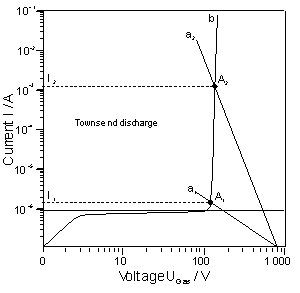
Functional principle of the IR converter
In more details the functional principal of the IR converter is explained with help of following illustration of load lines which represent a small part of the semiconductor-gas discharge system.

Current-voltage
characteristic of gas discharge layer.
The resistance of the selected part of semiconductor is a shunt resistor for the gas discharge. The position of loadline of the shunt resistor is defined by its conductance (straight line a1 and a2). The gradient of the loadline is proportional to local conductance of the semiconductor and this value is proportional to the incoming irradiation. The shunt resistor and the power supply are charged by "the resistance of the gas discharge" which has the characteristic line b. This caracteristic has an almost vertical devolution in the so called Townsend regime. Let us assume for instance that line A1 corresponds to no incoming radiation respectively dark current. By increasing incoming IR irradiation on the input of the IR converter the slope of the line rises and the operating point shifts from A1 to A2. For this reason the current incrases from I1 to I2 and in consequence of this the emission of the visible light of the gas discharge increases, as well. On the one hand the slope is proportional to incoming intensity of IR irradiation, on the other hand current and intensity of emitted light in the visible is proprotional as well.